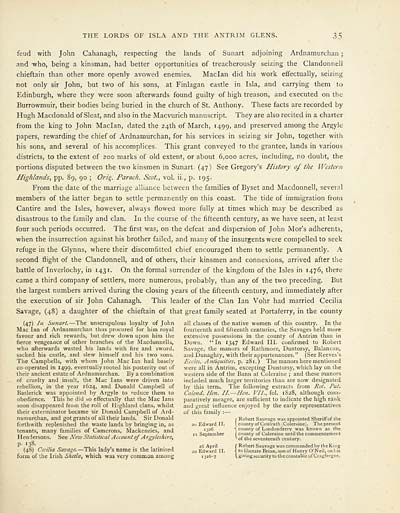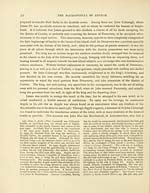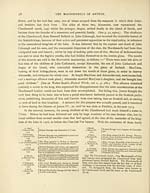Historical account of the Macdonnells of Antrim
(49) Page 35
Download files
Complete book:
Individual page:
Thumbnail gallery: Grid view | List view

THE LORDS OF ISLA AND THE ANTRIM GLENS. 35
feud with John Cahanagh, respecting the lands of Sunart adjoining Ardnamurchan ;
and who, being a kinsman, had better opportunities of treacherously seizing the Clandonnell
chieftain than other more openly avowed enemies. Maclan did his work effectually, seizing
not only sir John, but two of his sons, at Finlagan castle in Isla, and carrying them to
Edinburgh, where they were soon afterwards found guilty of high treason, and executed on the
Burrowmuir, their bodies being buried in the church of St. Anthony. These facts are recorded by
Hugh Macdonald of Sleat, and also in the Macvurich manuscript. They are also recited in a charter
from the king to John Maclan, dated the 24th of March, 1499, and preserved among the Argyle
papers, rewarding the chief of Ardnamurchan, for his services in seizing sir John, together with
his sons, and several of his accomplices. This grant conveyed to the grantee, lands in various
districts, to the extent of 200 marks of old extent, or about 6,000 acres, including, no doubt, the
portions disputed between the two kinsmen in Sunart. (47) See Gregory's History of the Western
Highlands, pp. 89, 90 ; Orig. Paroch. Scot., vol. ii., p. 195.
From the date of the marriage alliance between the families of Byset and Macdonnell, several
members of the latter began to settle permanently on this coast. The tide of immigration from
Cantire and the Isles, however, always flowed more fully at times which may be described as
disastrous to the family and clan. In the course of the fifteenth century, as we have seen, at least
four such periods occurred. The first was, on the defeat and dispersion of John Mor's adherents,
when the insurrection against his brother failed, and many of the insurgents were compelled to seek
refuge in the Glynns, where their discomfitted chief encouraged them to settle permanently. A
second flight of the Clandonnell, and of others, their kinsmen and connexions, arrived after the
battle of Inverlochy, in 1431. On the formal surrender of the kingdom of the Isles in 1476, there
came a third company of settlers, more numerous, probably, than any of the two preceding. But
the largest numbers arrived during the closing years of the fifteenth century, and immediately after
the execution of sir John Cahanagh. This leader of the Clan Ian Vohr had married Cecilia
Savage, (48) a daughter of the chieftain of that great family seated at Portaferry, in the county
(47) In Sunart. — The unscrupulous loyalty of John all classes of the native women of this country. In the
Mac Ian of Ardnamurchan thus procured for him royal fourteenth and fifteenth centuries, the Savages held more
favour and rich rewards, but drew down upon him the extensive possessions in the county of Antrim than in
fierce vengeance of other branches of the Macdonnells, Down. "In 1347 Edward III. confirmed to Robert
who afterwards wasted his lands with fire and sword, Savage, the manors of Rathmore, Duntorsy, Balancan,
sacked his castle, and slew himself and his two sons. and Dunaghty, with their appurtenances. " (See Reeves's
The Campbells, with whom John Mac Ian had basely Eccles. Antiquities, p. 281.) The manors here mentioned
co-operated in 1499, eventually rooted his posterity out of were all in Antrim, excepting Duntorsy, which lay on the
their ancient estate of Ardnamurchan. By a combination western side of the Bann at Coleraine ; and these manors
of cruelty and insult, the Mac Ians were driven into included much larger territories than are now designated
rebellion, in the year 1624, and Donald Campbell of by this term. The following extracts from Rot. Pat.
Baslerick was appointed by Argyle to reduce them to Calend. Hen. II. — Hen. VII., fol. 1828, although com-
obedience. This he did so effectually that the Mac Ians paratively meagre, are sufficient to indicate the high rank
soon disappeared from the roll of Highland clans, whilst and great influence enjoyed by the early representatives
their exterminator became sir Donald Campbell of Ard- of this family : —
namurchan, and got grants of all their lands. Sir Donald Robert Sauvage was appointed Sheriff of the
forthwith replenished the waste lands by bringing in, as 20 Edward II. county of Coulrath (Coleraine). Thepresent
tenants, many families of Camerons, Mackenzies, and ' 326 u ' conM . y °r Londonderry was known as the
T , , ' J c ., «. .. .. , . * j- a 77. 11 September county of Coleraine until the commencement
Hendersons. See New Statistical Account oj Argylesnire, r i- of the seventeenth century.
P ' , ->.' ^ ... „ —,, . , , , .,,.., 26 April f Robert Sauvage was commanded bv the King
(48) Cecilia Savage. — 1 his lady s name is the latinised 20 EdwardII. \ to liberate Brian, son of Henry O'Neil, on his
form of the Irish Sheela, which was very common among 1326-7 \ giving security to the constable of Cragfergus.
feud with John Cahanagh, respecting the lands of Sunart adjoining Ardnamurchan ;
and who, being a kinsman, had better opportunities of treacherously seizing the Clandonnell
chieftain than other more openly avowed enemies. Maclan did his work effectually, seizing
not only sir John, but two of his sons, at Finlagan castle in Isla, and carrying them to
Edinburgh, where they were soon afterwards found guilty of high treason, and executed on the
Burrowmuir, their bodies being buried in the church of St. Anthony. These facts are recorded by
Hugh Macdonald of Sleat, and also in the Macvurich manuscript. They are also recited in a charter
from the king to John Maclan, dated the 24th of March, 1499, and preserved among the Argyle
papers, rewarding the chief of Ardnamurchan, for his services in seizing sir John, together with
his sons, and several of his accomplices. This grant conveyed to the grantee, lands in various
districts, to the extent of 200 marks of old extent, or about 6,000 acres, including, no doubt, the
portions disputed between the two kinsmen in Sunart. (47) See Gregory's History of the Western
Highlands, pp. 89, 90 ; Orig. Paroch. Scot., vol. ii., p. 195.
From the date of the marriage alliance between the families of Byset and Macdonnell, several
members of the latter began to settle permanently on this coast. The tide of immigration from
Cantire and the Isles, however, always flowed more fully at times which may be described as
disastrous to the family and clan. In the course of the fifteenth century, as we have seen, at least
four such periods occurred. The first was, on the defeat and dispersion of John Mor's adherents,
when the insurrection against his brother failed, and many of the insurgents were compelled to seek
refuge in the Glynns, where their discomfitted chief encouraged them to settle permanently. A
second flight of the Clandonnell, and of others, their kinsmen and connexions, arrived after the
battle of Inverlochy, in 1431. On the formal surrender of the kingdom of the Isles in 1476, there
came a third company of settlers, more numerous, probably, than any of the two preceding. But
the largest numbers arrived during the closing years of the fifteenth century, and immediately after
the execution of sir John Cahanagh. This leader of the Clan Ian Vohr had married Cecilia
Savage, (48) a daughter of the chieftain of that great family seated at Portaferry, in the county
(47) In Sunart. — The unscrupulous loyalty of John all classes of the native women of this country. In the
Mac Ian of Ardnamurchan thus procured for him royal fourteenth and fifteenth centuries, the Savages held more
favour and rich rewards, but drew down upon him the extensive possessions in the county of Antrim than in
fierce vengeance of other branches of the Macdonnells, Down. "In 1347 Edward III. confirmed to Robert
who afterwards wasted his lands with fire and sword, Savage, the manors of Rathmore, Duntorsy, Balancan,
sacked his castle, and slew himself and his two sons. and Dunaghty, with their appurtenances. " (See Reeves's
The Campbells, with whom John Mac Ian had basely Eccles. Antiquities, p. 281.) The manors here mentioned
co-operated in 1499, eventually rooted his posterity out of were all in Antrim, excepting Duntorsy, which lay on the
their ancient estate of Ardnamurchan. By a combination western side of the Bann at Coleraine ; and these manors
of cruelty and insult, the Mac Ians were driven into included much larger territories than are now designated
rebellion, in the year 1624, and Donald Campbell of by this term. The following extracts from Rot. Pat.
Baslerick was appointed by Argyle to reduce them to Calend. Hen. II. — Hen. VII., fol. 1828, although com-
obedience. This he did so effectually that the Mac Ians paratively meagre, are sufficient to indicate the high rank
soon disappeared from the roll of Highland clans, whilst and great influence enjoyed by the early representatives
their exterminator became sir Donald Campbell of Ard- of this family : —
namurchan, and got grants of all their lands. Sir Donald Robert Sauvage was appointed Sheriff of the
forthwith replenished the waste lands by bringing in, as 20 Edward II. county of Coulrath (Coleraine). Thepresent
tenants, many families of Camerons, Mackenzies, and ' 326 u ' conM . y °r Londonderry was known as the
T , , ' J c ., «. .. .. , . * j- a 77. 11 September county of Coleraine until the commencement
Hendersons. See New Statistical Account oj Argylesnire, r i- of the seventeenth century.
P ' , ->.' ^ ... „ —,, . , , , .,,.., 26 April f Robert Sauvage was commanded bv the King
(48) Cecilia Savage. — 1 his lady s name is the latinised 20 EdwardII. \ to liberate Brian, son of Henry O'Neil, on his
form of the Irish Sheela, which was very common among 1326-7 \ giving security to the constable of Cragfergus.
Set display mode to:
![]() Universal Viewer |
Universal Viewer | ![]() Mirador |
Large image | Transcription
Mirador |
Large image | Transcription
Images and transcriptions on this page, including medium image downloads, may be used under the Creative Commons Attribution 4.0 International Licence unless otherwise stated. ![]()
| Histories of Scottish families > Historical account of the Macdonnells of Antrim > (49) Page 35 |
|---|
| Permanent URL | https://digital.nls.uk/95341835 |
|---|
| Description | A selection of almost 400 printed items relating to the history of Scottish families, mostly dating from the 19th and early 20th centuries. Includes memoirs, genealogies and clan histories, with a few produced by emigrant families. The earliest family history goes back to AD 916. |
|---|

